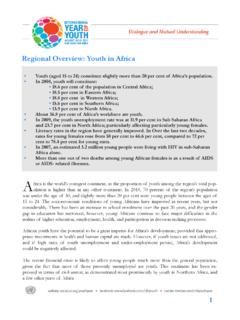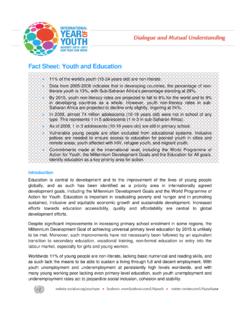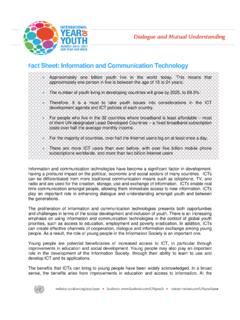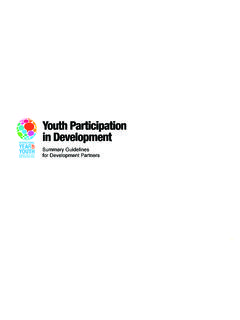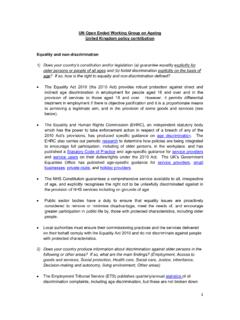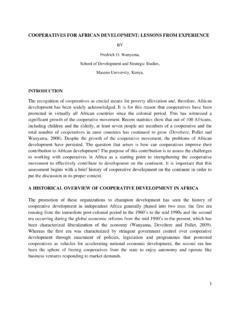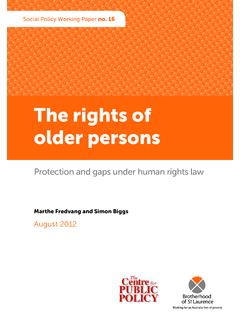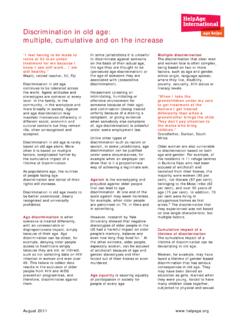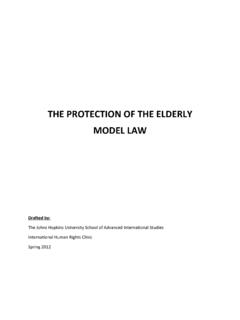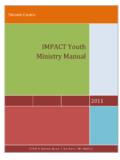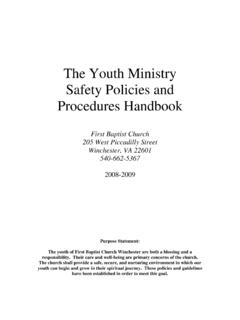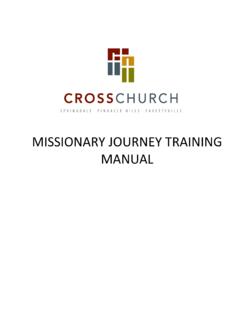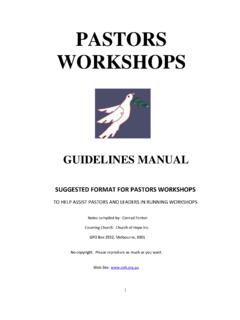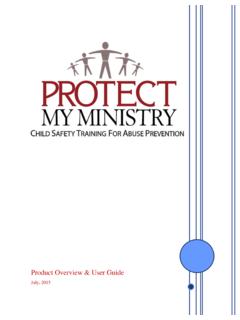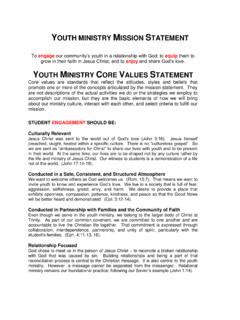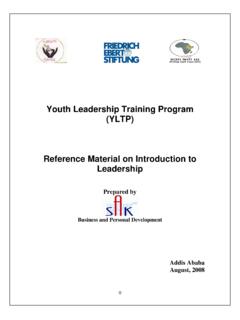Transcription of Youth Participation in Development - DSPD
1 Youth Participation in DevelopmentSummary Guidelines for Development PartnersCONTENTSP05 - Introduction P06 - Why work with youthP08 - Youth ParticipationP09 - Policy Frameworks P10 - Introduction to Case studies P12 - Organisational Development case studies P16 - Policy and planning case studies P20 - Implementation case studies P24 - Monitoring and evaluation case studies P26 - Conclusion2 CONTENTSP05 - Introduction P06 - Why work with youthP08 - Youth ParticipationP09 - Policy Frameworks P10 - Case studies P10 - Introduction P12 - Organisational Development case studies P16 - Policy and planning case studies P20 - Implementation case studies P24 - Monitoring and evaluation case studies P26 - Conclusion2 PURPOSE OF THIS DOCUMENT !e purpose of this document is to: a) Increase understanding of the growing importance of, and greater potential for, Youth Participation in Development practice specifically for donor agen-cies and policy makers.
2 B) Provide some initial practical guidance to assist donor agencies and policy makers to work more effectively with and for young people. !is document is a summary of the 2010 publication Youth Participation in Development A Guide for Development Agencies and Policy Makers. "e original publication was developed by the DFID-CSO Youth Working Group coordinated by Restless Development , working in partnership with DFID, the World Bank, UNICEF, UNFPA and other donor agencies, with contributions from a wide range of civil society partners, all listed in the full publication. "is summary document was produced by Restless Development and the Unit-ed Nations (UN) Programme on Youth . Readers interested to know more about the issues, case studies and tools referenced in this summary document should read the full Guide, available from Restless Development , the UN Programme on Youth , or by download at Association of Youth Organisations NepalDFID UK Department for International DevelopmentGTZ German Technical Co-operationGOYS Government Department for Youth and Sport, BahrainMDGs Millennium Development GoalsM&E Monitoring and EvaluationNDP National Development PlanNORAD Norwegian Agency for Development Co-operationNGO Non-governmental OrganisationPRSP Poverty Reduction Strategy PaperSRHR Sexual and reproductive health and rightsUK United Kingdom of Great Britain and Northern IrelandUN United NationsUNAIDS "e Joint United Nations Programme on HIV/AIDSUNDP United Nations Development ProgrammeUNESCO United Nations Economic.
3 Social and Cultural OrganisationUNFPA United Nations Populations FundUN-HABITAT United Nations Human Settlement ProgrammeUNICEF United Nations Children s FundUSAID United States Agency for International DevelopmentWHO World Health OrganizationWPAY World Programme of Action for YouthWRC Women s Refugee CommissionYEAH Young, Empowered and HealthyYGP Youth Guidance Project3 We must fulfil our obligations toyouth. !e World Programme of Actionfor Youth asks Governments to considerthe contributions of young persons on allpolicies affecting them. Governments must honour this commitment. !ey must alsoincrease the financial, education and technical support made available to young is high time that we stopped viewing our young people as part of the problem and startedcultivating their promise and potential. Ban Ki-moon, UN Secretary General, International Youth Day 20074 INTRODUCTIONO verview"e guide has been developed to assist Development partners working withand for Youth including Governments, donor agencies, policy makers, NGOsand civil society [1] and to increase understanding of the growing importance of,and greater potential for, Youth Participation in Development .
4 The Guide goes beyond the rhetoric of many policy advocacy papers by exploring key issues and approaches and providing practical information on how to work with Youth at the operation level in respect of policy and programming. It does this through the provision of promising practice case studies that will help organisations to get started. Please note that the full guide ( ) also sets out a number of quality standards to use as reference. !e three-lens approach to Youth participationDevelopment assistance should work for the benefit of Youth (as target benefic-iaries), with Youth as partners, and be shaped by Youth as leaders [2] (Figure 1). This is an assets approach to Youth Participation in Development which appreci-ates and mobilizes individual or group talents and strengths, rather than focusing only on deficits (needs), problems or threats and is referred to as the three-lens approach to Youth Participation .
5 1 Throughout the document the term Development partners is used and includes policy makers and government partners. The term Youth is used interchangeably with young people 2 DFID/Maguire, S. (2007) Youth Mapping Study DFID s Approach to Young People *Adapted from: World Bank Development report 2007It is important for institutions and practitioners to consider all three lenses; they are not mutually exclusive. Youth Participation in Development is often a com-bination of all three. "e different lenses may be used with different groups of young people during an intervention/initiative, , young leaders may be reach-ing out to new groups of young people as targets. "e ultimate aim is to de-velop Youth as partners and leaders in Development . This is based on Youth having agency: their capacity to act, their skills and capabilities and their ability to change their own lives and is the central tenet of the asset based approach to Youth AP-PROACH TO Youth Participation - Working for Youth as a beneficiary- Engaging Youth as a partner- Supporting Youth as leaders KEY OPERATIONAL AREAS FOR Youth Participation - Operational Development - Policy and planning- Implementation- Monitoring and evaluationQUALITY STANDARDS GETTING STARTEDCASE STUDIESSHARING PROMISING PRACTICE to learn from, adapt and replicate5 WHY WORK WITH Youth ?
6 Why work with Youth ? !e demographic imperative: The Youth bulgeNearly 50% of the developing world population is Youth and children3. "ere are billion 15 to 24 year olds in the world and one billion live in developing coun-tries4. "is is often referred to as the Youth bulge 5, as young people constitute a high and peaking proportion of many populations."e Youth bulge represents both a challenge and an opportunity for develop-ment. For example, in Uganda it is estimated that the country needs to create over 600,000 new jobs per year for the next 12 years equivalent to the total size of the formal employment sector at present. If this is not achieved, it will be impossible to reach the Millennium Development Goals targets, particularly on extreme poverty and hunger (MDG 1), child mortality (MDG 4), and environ-mental sustainability (MDG 7).!ese large numbers of young people are an opportunity; an investment.
7 Youth Participation in Development : Strengthens young people s abilities to meet their own subsistence needs; Prevents and reduces vulnerabilities to economic, political and socially unsta-ble environments; Promotes ownership and sustainability of interventions; Helps gain entry into target communities and builds up trust and social youthFor statistical purposes, the UN defines Youth as individuals between the ages of 15 and 24. Youth do not constitute a homogeneous group; their socio-eco-nomic, demographic and geographical situations vary widely both within and between regions. Notwithstanding these differences, regional-level analysis pro-vides a general understanding of their Development profile. Some 87 per cent live in developing countries and face challenges deriving from limited access to resources, education, training, employment, and broader economic develop-ment World Bank 20104 2005 figures, UN Population Division, World Population Prospects, 2008 Revision5 Research undertaken by Henrick Urdal at the Uppsala Conflict Data Program, Uppsala University, 2007: high Youth bulges indicate countries at risk when combined with economic stresses, but they are not necessarily a predictor of conflict6 However, it is necessary to move beyond the age dimension, and additionally focus on the transitional experiences of being young7.
8 "is means acknowledg-ing localised cultural understandings of childhood and adulthood. On the one hand, these may construct Youth as something which lasts well into one s 20s - particularly if economic realities exclude young adults from work, home own-ership or marriage. On the other hand, in many poverty situations, adult care/working responsibilities begin before the age of work with Youth ? Aid effectivenessEnabling young people to engage with democracy, Development and peace building: Enables the exercise of citizenship: making claims and holding governments and donor agencies to account (Paris principle:9 mutual accountability. ) Exer-cise of citizenship rights and duties in Youth are durable and often determine political Participation later in adulthood10. Participation promotes learning, empowerment and greater control over lives, which enables a wide range of voices to be heard.
9 Makes policies and services appropriate for Youth : building young people s commitment to the solutions (Paris principle: ownership ). Makes the MDGs a reality: the World Bank, UNFPA and the CommonwealthSecretariat have identified Youth as critical to reaching the MDGs (Paris principle: managing for results ).Box 1: Youth engagement: success stories Young people and adults share joint responsibility on the advisory board to "e UN-HABITAT Opportunities Fund for Urban Youth -led Development , targeting Youth -led initiatives in slums and squatter settlements that are in urgent need of financial support (p14). "e Municipality of Rosario in Argentina undertakes a participatory Youth budget which engages 1,000 Youth annually from across its six districts to select representa-tives and decide upon budget allocations for Youth services (p22).
10 In Bahrain, around 16,000 young people aged 15 to 30 ( of the Youth popula-tion) were engaged directly (through focus group discussions and surveys) or indi-rectly as part of formulating national Youth policy (p16). By the year 2015, there will be threebillion people under the age of 25. !ey are the future .. they are also the now James D. Wolfensohn,Former President of the World Bank (2003)7 DFID 2007, 2009, World Bank 20078 World Bank 2007, UN 20079 "e Paris Principles (adopted by the UN in 1992) relate to the status and functioning of national institutions for the protection and promotion of human rights10 World Bank 2007788 Engage young people in the AIDS response, ensure education and employment opportunities to reduce vulnerability to HIV, provide Youth -friendly health services Ensure the full and effective Participation of Youth in the life of society and in decision-making processes by.
